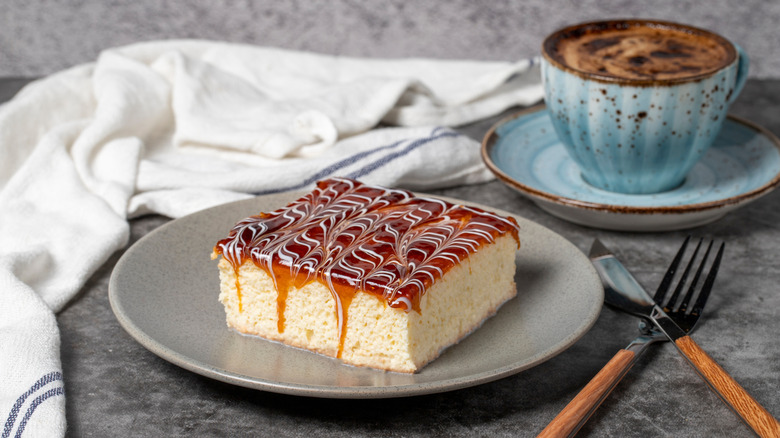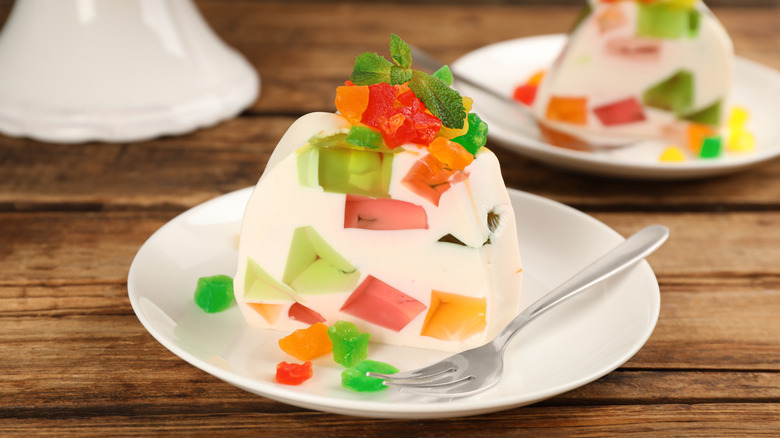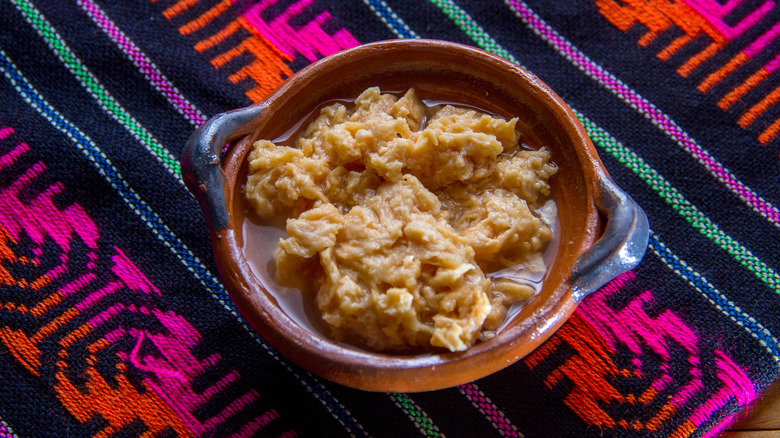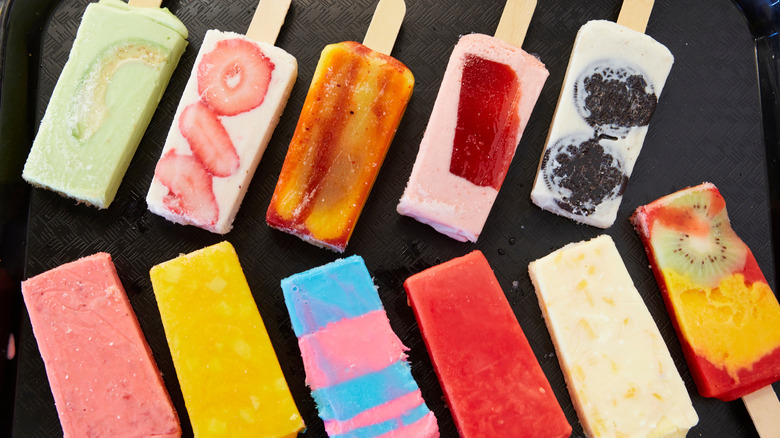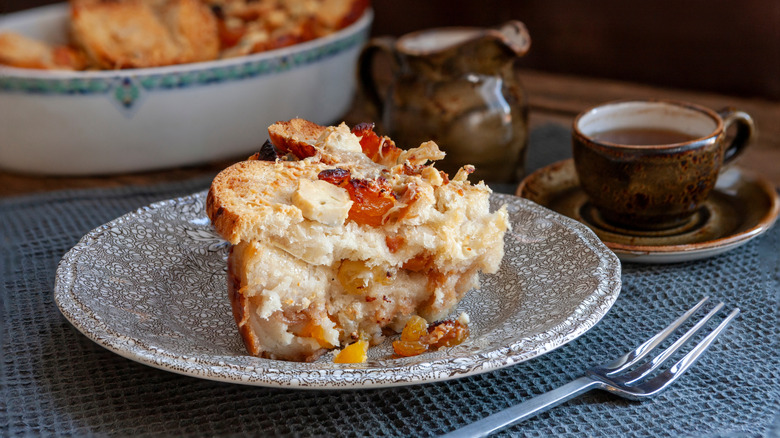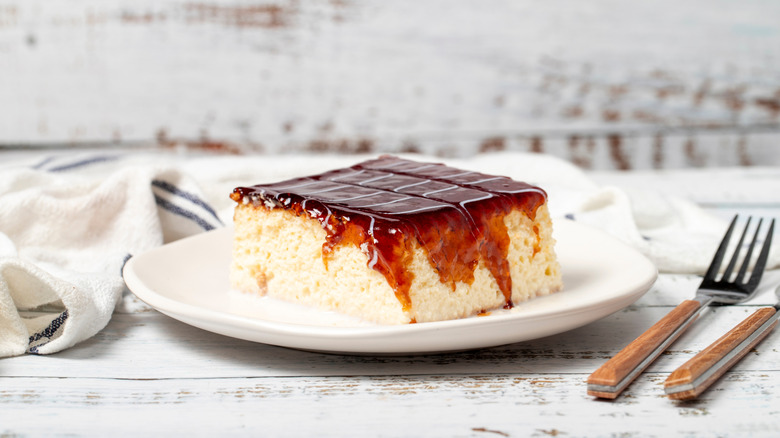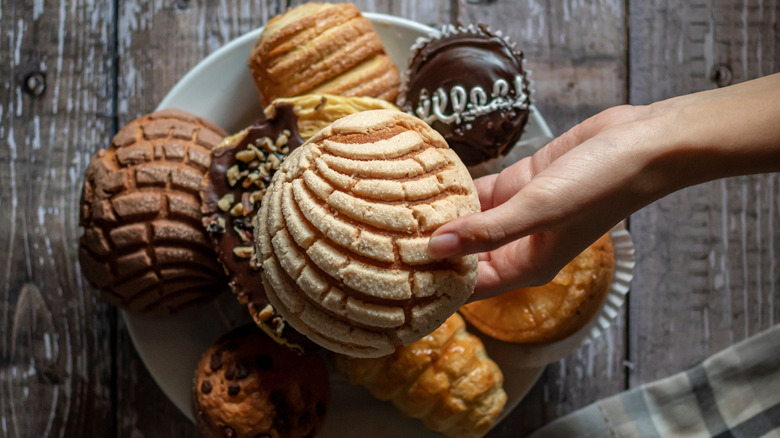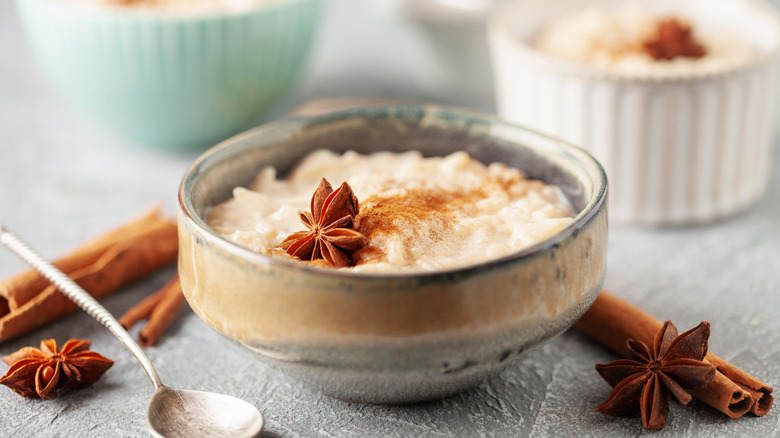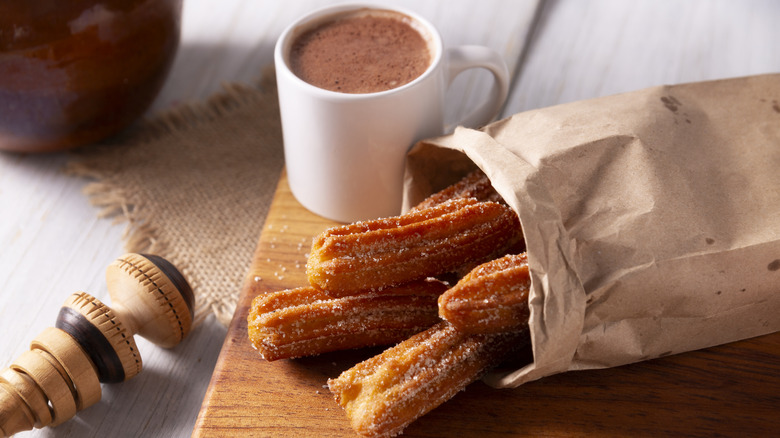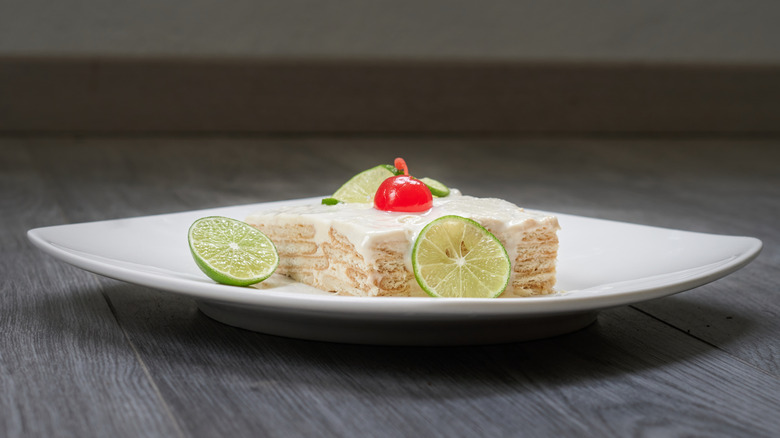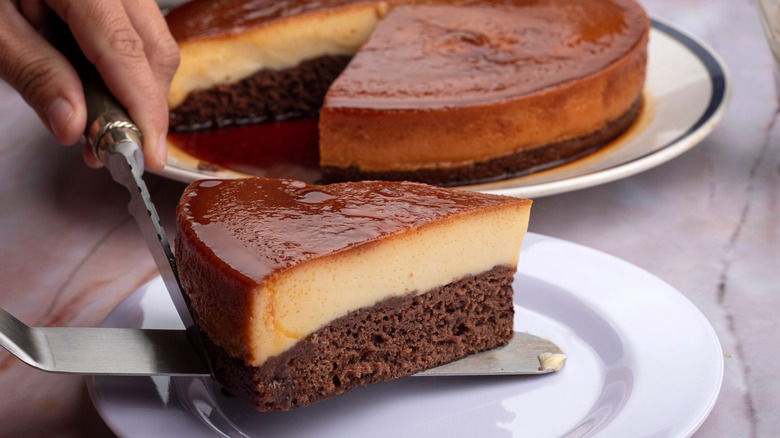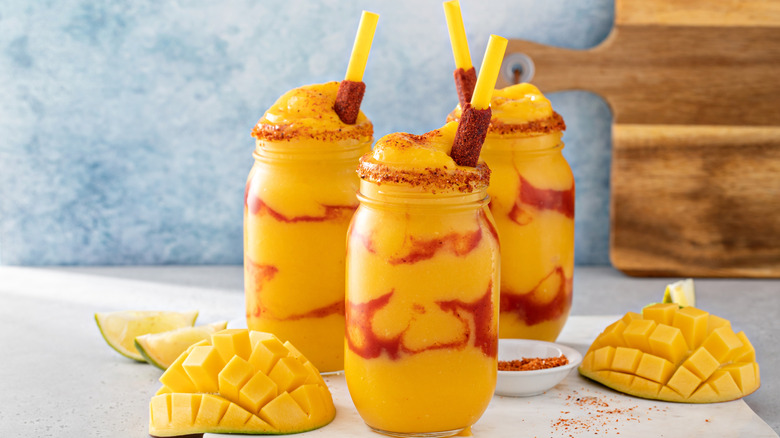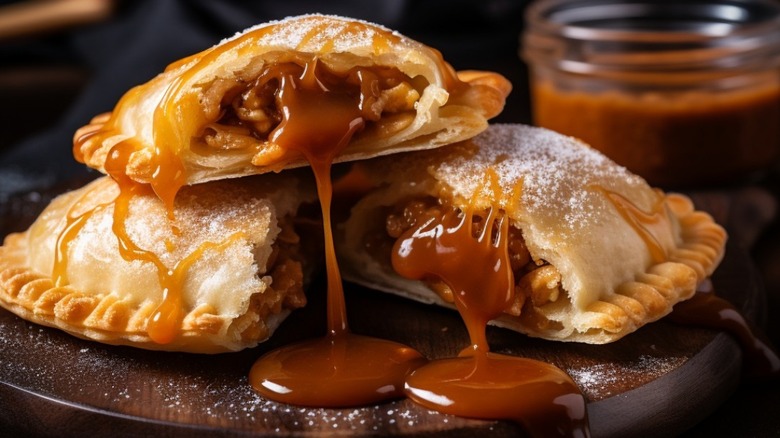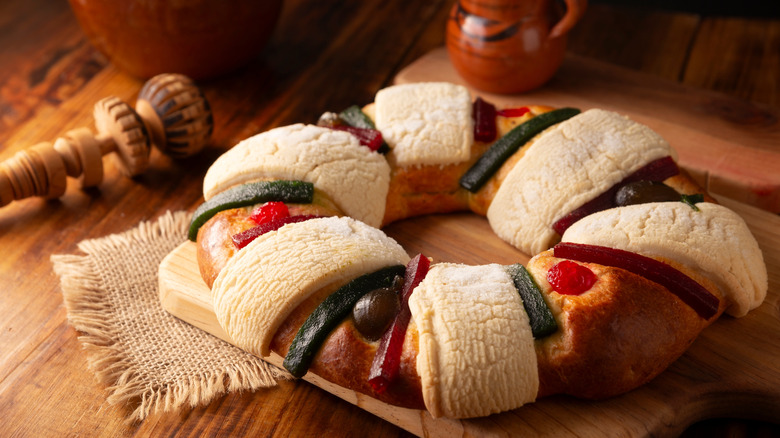13 Mexican Desserts Everyone Should Try At Least Once
We may receive a commission on purchases made from links.
When many people think of Mexican cuisine, they think of savory eats like tacos, tortas, and seafood. However, sweet treats are also very much a part of the culinary landscape. In nearly every city and town in Mexico, you can find panaderías stocked with sugary pan dulces and street vendors frying up fresh churros. Desserts show up all over the place, and not just at the end of a meal, but also as snacks, breakfast, or something to enjoy with coffee. Some sweet treats are tied to specific holidays and celebrations, while others are the kind of thing you might grab on a walk home. And like the rest of Mexican cooking, there's a ton of variety depending on where you are.
I've lived in Mexico for several years now, and while I expected to fall in love with the huge variety of tacos (which I did), I didn't realize how much I'd come to appreciate the sweets as well. Some were familiar, like popsicle-style paletas and tres leches cake, but a lot were completely new to me. Over the years, I've tried dozens of Mexican desserts, including homemade classics and regional specialties that aren't always easy to find outside the country. Here are 13 that I think everyone should try at least once.
Gelatinas
Pretty much anywhere desserts are served or sold in Mexico, you'll find gelatinas. These jiggly gelatin desserts come layered in cups, molded into cakes and domes, and even shaped into cartoon characters or elaborate flowers. They also come in a range of flavors, including lime, strawberry, pineapple, vanilla, and rompope (a Mexican spiked drink similar to eggnog). Like Jell-O creations, gelatinas are made by dissolving powdered gelatin in hot water or milk. Some people also get creative and add ingredients like custard, fresh fruit, nuts, and candies to the desserts.
One of the most popular types of gelatin desserts in Mexico is gelatina de mosaico (mosaic gelatin). It's made by preparing different colors and flavors of gelatin, then cutting them into cubes and mixing them into a creamy gelatin base that often includes cream and sweetened condensed milk. Some versions feature coconut milk, vanilla extract, or even liquor. After the whole thing solidifies, you can cut slices that will reveal jewel-colored cubes suspended in the milky mold in a pattern reminiscent of a mosaic.
Chongos zamoranos
At first glance, chongos zamoranos doesn't look particularly appetizing with its wet, beige-colored curds that sometimes sit in a pool of liquid. However, take a bite and you'll find that it's sweet and creamy with notes of cinnamon, sugar, and just a touch of lemon. The dish is basically curdled milk, and it can be made by cooking milk down slowly until curds form or by heating milk, then adding lemon juice or rennet to create the curds. Cinnamon sticks and sugar are also added to give the dessert its sweetness and baking spice flavor. It's typically served cold or at room temperature.
Chongo zamoranos originated in the city of Zamora in the state of Michoacán. According to some sources, legend has it that a nun at a convent created it as a way to use up milk that had spoiled. In Mexico, the word "chongo" refers to a hair bun or chignon, and some believe the dish got its name because the curds have the same shape as the hairstyle. Today, chongos zamoranos is wildly popular in its birthplace, with some enterprising vendors even selling canned versions of the dessert. It can be harder to find outside of Michoacán, though.
Paletas
Paletas and popsicles are similar in that they're both colorful frozen treats on sticks. But while American-style popsicles are typically made with artificially flavored and colored sugar syrups, paletas are almost always made with natural ingredients like fresh fruit, herbs, and sometimes milk. They come in a range of flavors, including mango, tamarind with chamoy, cucumber with chili, and strawberries with cream. Some are smooth with pureed ingredients, and others feature chunks of fruit, cookies, or nuts.
Across Mexico, one name has become synonymous with paletas, and that is La Michoacana. You'll find hundreds of paleterías with that name across the country, but they're not all franchises. There is some dispute over who created the first La Michoacana paletería, although many sources state that it was likely an ice cream maker from Michoacán who built up a thriving paletas business sometime in the early or mid-20th century. Soon after, other people began capitalizing on the name. While the shops may not be united under one parent company, the experience is basically the same at most — step inside and you'll find an array of iced treats in a rainbow of colors and flavors to suit all palates.
Capirotada
Capirotada has come a long way since its early days in 15th-century Spain. It started out as a savory dish made with stale bread, meat, and cheese. Over time, it evolved to include sweet ingredients like syrup and warming spices like cinnamon. When capirotada made its way to Mexico, it evolved yet again to include local ingredients like piloncillo (raw cane sugar) and Cotija cheese. It also took on religious significance with the bread representing the body of Christ and the syrup representing Christ's blood.
Today, capirotada is a bread pudding dessert that's popular in Mexico around Lent. Recipes vary with different families putting their own spin on the dish, but it usually consists of a base of bolillo bread (rolls that are often used for Mexican sandwiches called tortas). The bread is doused with piloncillo syrup or sweetened milk flavored with cinnamon and topped with salty cheese. Many people also add fresh or dried fruit and nuts to the mix. The whole thing is baked until it's golden on top and fluffy inside. Some people serve it with sprinkles or ice cream on top.
Pastel de tres leches
It's easy to see why tres leches cake is so popular. It's moist, sweet, and decadent, but not so heavy that you feel like you need a nap after indulging in a slice. This creamy dessert consists of sponge cake soaked in three different milks, hence the name "tres leches." Whole milk or cream gives it freshness, while evaporated milk and condensed milk add richness and sweetness. Some people also top the cake with whipped cream and a dusting of cinnamon. Dulce de leche and fresh fruit are also popular toppings.
There is considerable debate over the origins of pastel de tres leches, with Mexico and Nicaragua both laying claim to creating the cake. Both countries have versions of soaked cakes that predate tres leches, many of which were likely influenced by European soaked cakes like trifles and rum cake. When Nestlé expanded into Latin America during World War II, canned milk products became more readily available, and that undoubtedly gave rise to the tres leches cake. Wherever it was created, the recipe spread across the region, and now the cake is a beloved dessert in Latin America and beyond.
Pan dulce
Living in Mexico, it didn't take long to figure out that pan dulce is a big deal, especially around breakfast time. Visit a bakery in Mexico City or any other busy Mexican city, and you'll likely find long lines of people waiting to get their fix of sweet pastries and bread. Pan dulces come in all shapes and sizes, and they're typically rich, buttery, and sweet. They're perfect for dunking in coffee or hot chocolate, which makes them great for breakfast, a coffee break, or an after-dinner treat.
One of the most popular pan dulces in Mexico is the concha, a fluffy roll that's covered in a crunchy, sweet crust. The name translates to "seashell," and it refers to the striated shape of the crust. Conchas can be vanilla, chocolate, or strawberry flavored. Other popular sweet breads include flaky orejas that are shaped like ears and Garibaldi cakes covered in apricot jam and sprinkles. Around Día de los Muertos, you can also find pan de muerto, which is a sweet bun that's often flavored with orange zest and has a cross-like shape on top. Some pan de muerto also have luscious creamy fillings.
Arroz con leche
For many people in Mexico, arroz con leche (aka rice pudding) tastes like childhood. It's simple, comforting, and can be made with just a few ingredients. All you need is rice, milk, sugar, and maybe a dash of cinnamon to make this homey dessert. Recipes vary from home to home, with some people adding evaporated milk or sweetened condensed milk in the rice pudding to make it a bit sweeter and creamier. Optional add-ins include citrus zest, raisins, chopped nuts, and shredded coconut.
While arroz con leche is typically a low-key dessert made with simple, affordable ingredients, there's nothing to say you can't amp the dish up a notch or two. Instead of using long-grain white rice, you could opt for Arborio, which has plump grains that take on a creamy consistency when they soak up the milk. You could also consider making a tres leches rice pudding by cooking the rice with a cinnamon stick, then simmering it with whole milk, evaporated milk, and condensed milk. The result is a velvety pudding that's layered with sweet, milky flavors.
Churros
Few desserts are as crowd-pleasing or as satisfying to eat piping hot as a well-made churro. You can find churros all over Mexico, from markets to roadside stands and chain restaurants dedicated to the crispy, fried treat. Churros consist of dough that's piped into hot oil and cooked until it's puffy, crispy, and golden. The churros are then dusted with cinnamon sugar and served as-is or with dips like melted chocolate or cajeta, a goat-milk caramel sauce that's similar to dulce de leche. Churros are such a beloved treat in Mexico that June 6 has been designated National Churro Day.
While churros are often associated with Mexico, they're actually one of several Mexican dishes that have international roots. Churros were brought to the country by the Spanish, but their true origins are a little harder to pin down. Some say that Spanish shepherds created churros as an easy way to make a snack while tending their Churra sheep. Others say that Portuguese traders may have discovered fritter-style snacks in China and brought the technique back to the Iberian Peninsula. Yet others say that the Arabs may have introduced the fried dough snack to Spain.
Carlota de limón
Love key lime pie? Carlota de limón hits many of the same notes, but with a no-bake twist that makes it perfect for hot days. It features just a few simple ingredients: crispy Marias cookies, evaporated milk, sweetened condensed milk, and key lime juice. Some people also add cream cheese or mascarpone for extra creaminess and tang. Everything gets layered together, and then it's put in the fridge. As it chills, the cookies soften into cake-like layers while the lime filling sets into a smooth, custard-like cream. Served cold and cut into squares, it's bright, refreshing, and just a touch rich.
It's not clear exactly when the carlota de limón was created, but many believe it was influenced by the Charlotte, a French dessert that features layered cookies or sponge cake. That makes sense, considering the French introduced many dishes and cooking techniques to Mexico during the French Intervention in the late 19th century. The dessert likely took on its icebox character after home refrigerators and freezers took off in the mid-20th century. Today, it's a well-known dish that many Mexicans grew up with. My partner remembers it fondly from childhood and still asks for it every birthday.
Chocoflan
Flan may have arrived in Mexico by way of Spain, but chocoflan is a homegrown invention, and a pretty brilliant one at that. Also known as "pastel imposible," or "impossible cake," it layers cajeta with dense chocolate cake and silky flan in the same pan. Interestingly, when you take it out of the oven, the order is reversed, with the cake on top and the flan on the bottom. This seemingly impossible feat happens because the flan is denser, so it sinks to the bottom as the cake rises.
Chocoflan requires a number of steps to make, but once you have all the elements ready to go, it's pretty easy to put together. You simply add a layer of cajeta to the bottom of a pan, then pour in your cake batter, followed by the flan mixture. The key is to bake it in a water bath, which helps the flan set gently without curdling. The cake also needs plenty of time to chill after baking so that the layers can firm up before you flip it. It's worth the wait, though, because you end up with a glossy, caramel-topped flan sitting perfectly atop rich, moist chocolate cake — no frosting required.
Mangonada
It's hard to find a more Instagrammable Mexican treat than the mangonada. This bright orange and red concoction is part dessert and part drink. Often served in a plastic cup, it features streaks of tangy red chamoy, slushy mango sorbet, tart lime juice, dashes of chili-lime Tajín powder, and chunks of juicy mango. It also gets a straw that's coated in tamarind paste and rolled in chili powder. It's a street-food favorite that's sweet, spicy, salty, and sour all at the same time, as well as ultra-refreshing.
One reason the mangonada is so beloved is that it's built on iconic Mexican flavors. Chamoy is a sweet, savory, and spicy sauce that's made from pickled fruit (often apricot or plum) and spiced with chili. It's used on everything from fresh fruit to chips. Tajín is a powdered seasoning made with chili, lime, and salt that adds a zesty kick and brings out the fruit's natural sweetness. The tamarind straw is a take on popular Mexican candies that feature tamarind. Then you have mango, which is ubiquitous and much loved across the country.
Empanadas dulces
Empanadas are best known as savory pastries filled with meat or cheese, but there are also sweet versions that are filled with fruit and dusted with sugar. Though the history of the empanada is a bit murky, the first record of the dish comes from a Spanish cookbook in the 16th century. It was originally a large, pie-like pastry filled with meat. When empanadas made their way to Latin America during colonization, the dish evolved based on local tastes and ingredients. The name comes from the Spanish word "empanar," which simply means "to wrap in bread," so there's a lot of leeway to play around with different fillings.
In Mexico, sweet empanadas are just as popular as their savory cousins, especially at panaderías and markets. The fillings can vary by region and season, but some of the most common include pineapple, apple, sweetened pumpkin, cajeta, and jammy guava paste. The dough is often slightly sweetened, and the empanadas are baked until golden, then finished with a dusting of sugar. Some versions have a flaky, almost pastry-like texture, while others are soft and pillowy.
Rosca de Reyes
Come late December and early January, bakeries around Mexico start stocking the shelves with colorful Rosca de Reyes. This orange-flavored sweet bread is shaped like a wreath and typically decorated with fruit like candied orange peels, cherries, and guava strips. It also gets strips of sugary dough that create patches of crunchy crust. The dessert is an absolute must for the celebration of Three Kings Day on January 6, also known as The Epiphany. It celebrates the day the three wise men came to Bethlehem and presented baby Jesus with gifts.
More than just a sweet treat, Rosca de Reyes also has a fun tradition that goes along with it. Hidden inside the bread is at least one small figurine representing baby Jesus. When the bread is sliced and shared, whoever finds the figurine in their piece is expected to host a gathering for Día de la Candelaria on February 2 and cook tamales for all the guests. I've also been served Rosca de Reyes at some businesses around the holiday that offered discounts or prizes to customers lucky enough to snag a slice with the baby Jesus inside.
